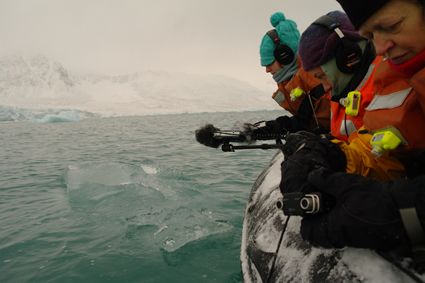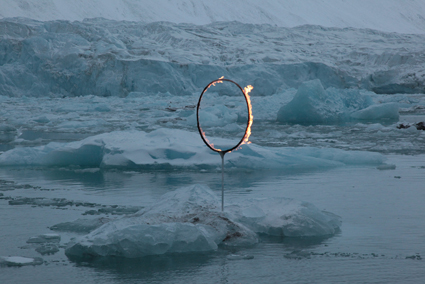art via the arctic portal
urszula dawkins: the arctic circle artist residency

Interviewing the ice, Arctice Circle Artist Residency
photo courtesy the artists
Interviewing the ice, Arctice Circle Artist Residency
TENG CHAO-MING IS MARKING OUT AN AREA OF SNOW WITH LONG RED POLES AND PHOTOGRAPHING HIS NEW, POTENTIAL ‘HOME.’ THE MEASUREMENTS EXACTLY MATCH HIS FAMILY’S TAIPEI HOUSE. BEHIND HIM, THE MOUNTAINS HIORTHFJELLET AND LOUISFJELLET TOWER, THEIR SLOPES MERGING INTO THE FOREGROUND AND SHARP SUMMITS BLOWN OUT INTO WHITE SKY. A FEW GREY LINES ETCHED ON THEIR FLANKS GIVE THEM FORM.
Nearby but just out of shot, Mexican/US artist Rebeca Méndez is filming herself trudging through knee-deep drifts with a substantial flagpole and Mexican flag. Her figure crosses the preview screen: a tiny, comical beetle at odds with the dramatic background. Halfway through the take, the whole flag assembly flutters wildly in a gust before completely collapsing.
‘Nearby but just out of shot’ is how it often works here, as 19 artists from around the world negotiate quasi-individual relationships with the ‘sublime’ landscapes of Norway’s Svalbard archipelago, on a two-week sailing voyage at around 80° North. Here at Advent City, a deserted mining town boasting little but boot-slashing strips of rusted metal, our last day’s work, October 20, is in progress under the watchful eye of an armed guide—polar bears are present throughout these islands.
october 12: gravneset, magdalenefjorden
High on the north-west coast, it’s perfectly okay for New York’s Janet Biggs to set up a video camera and brace herself: she fires a flare gun into the sky, releasing a cloud of red smoke along with crackling shock waves. Nobody registers it as a call for help, because there’s nobody else for hundreds of miles around. A snow-white fox leaps out of a hollow, though, and dashes for cover. Biggs’ installation, Anana Dream, was shown at PICA in Perth last year—a video loop of endlessly swimming, zoo-bound polar bears. 2010 is her second Arctic Circle residency; she aims to complete a video work—a “kayak ballet” that both addresses our presence here and engages directly with power, fantasy, gender and desire.
Early in the voyage, we feel our way in an environment that is, in a sense, both fairytale and nightmare. At Gravneset, artist and trained coastal engineer, Jane Chang Mi (USA) is zipped into a dry-suit and swims in the freezing shallows between chunks of glacier ice. Later in the trip she spends an entire day aboard ship while everyone else hikes, making delicate blue and white ‘postcards’ that reference Svalbard’s somewhat ironic history as a tourist destination.
Cameras are a safety valve for the unsure or overwhelmed: if in doubt, document. But photographers Christina Seely (USA) and Regina Kokoszka (USA) settle in with ease and purpose; so do painters Saul Becker (USA) and Carrie-Ann Bracco (USA). Belgian Eric van Hove also has a clear focus: working with a concocted ‘scientific instrument’ which he calls an “anthropochronic theodolite,” he photographs a landscape rendered inextricable from his tripod, pendulum and human femur assembly. He’s “surveying in the anthropocene era, and suggesting the instalment of a series of new survey markers which include the human presence as a geophysical force.”
Day after day we’re delivered to new shores to “make work.” The struggle to think, respond and maximise each opportunity competes with the practical necessity of ‘suiting up,’ watching our step on treacherously loose rock, or trying to stay in one place without freezing to death. The challenge is one of the strengths of the program. Over two weeks at sea, Bracco, for example, is a constant, almost iconic presence: although her paintings read as ‘traditional’ within the gamut of contemporary practices, her commitment to daily two-hour plein-air sessions (working in a mix of oils and, inevitably, snow) reflects the resilience of everyone on board.

Arjen de Leeuw, Hoop
photo courtesy the artists
Arjen de Leeuw, Hoop
october 17: monaco glacier, liefdefjorden
Around mid-voyage, our ship spends a whole day close to the formidable Monacobreen, its five-kilometre front of crumbling blue ice rising to 80 metres high. ‘Bitty-bergs’ drift around us; now and then the thunder of a bigger, calving berg carries from the near distance.
Dutch video artist and sculptor Arjen de Leeuw makes a connection between memory loss and the melting of Arctic ice. “I look at the glacial landscape as a centuries-old storage space of the earth’s memory,” he says. “As the ice and its data moves into the sea, this data is no longer available, it is gone forever.” De Leeuw is making a film featuring our group as ‘cast’; Wendy Jacob (USA) has been co-opted as a scientist who has lost her memory. At Monacobreen, de Leeuw sets a flaming hoop on a chunk of floating ice and films the drifting, incongruous scene.
Wendy Jacob has a coincidental interest in glacial ice and its millenia-old air bubbles, whose sounds she hopes to record and embed in a tactile sound installation. Perth choreographer/performer Aimee Smith is also recording, fascinated with both the visual and sonic ‘fracturing’ of ice. (Smith is undertaking a development with dancers Aisling Donovan and Sharlene Campbell in December 2010, focused around the complications of water as a resource, and responding to The Arctic Circle experience.) Danish artist Eva la Cour joins Smith and Jacob for a Zodiac trip closer to the glacier to, as La Cour puts it, “interview the ice.” The scene is slightly absurd: three heavily-clad bodies, faces mostly hidden but brows furrowed, pointing recording devices at blobs of ticking, popping, whistling, melting ice as it bobs elusively by.
The absurdity of all artistic endeavour in the Arctic (or perhaps anywhere) is central to Chad Stayrook’s (USA) work. At every opportunity, he sets up a gigantic cardboard ‘telescope’ and is documented surveying the landscape searchingly; or co-opts others into wielding mysterious ‘tools’ “to interpret the unknown.” At Monacobreen, he zips back and forth amid the ice in the Zodiac, perched with his ’scope in the bow; his work aims to expose “the futile nature of such a search, as well as the liberation one might find within the futility.” Inspired in some degree by Melville’s Moby Dick, his solo show, The Search for an Unattainable Beast, opens in San Francisco in December.
october 14: moffen island
Our furthest point north is Moffen Island, startlingly different from Svalbard’s mountains and fjords—just a barely-exposed shoal covered in snow and driftwood. The absurdity continues: Temujin Doran (UK) and several others set up a ludicrous bocce game with coloured aluminium fishing floats—every activity here somehow takes on the sense of an ‘intervention.’ Rebeca Méndez manages to complete a film piece, Recurrence Relation #2—complementing earlier work in Iceland—despite driving, horizontal snow.
Laurie Palmer (USA) is one of several participants with specific interest in science, particularly “signs and markers of very slow time” including extremophile bacteria and lichens, some of which spend thousands of years chewing their way through rock. On Moffen she attempts to collect core ice samples with equipment borrowed from the University of Svalbard, hoping to have it analysed for “extreme life and extreme chemical inclusions.” Palmer is “looking for what is invisible in all that obviously spectacular landscape” and for changes “on scales other than human.”
Returning to the Arctic for her second voyage, Raphaele Shirley (USA) spends her time on Moffen filming the groups of walruses that swim up to the shore to examine us, in hope of completing a sequel to her film, StarGaze in Sandnes. Describing the immense and disarmingly curious walruses as “like some kind of oddly formed gods of antiquity,” Shirley articulates a desire to “echo the harmony of the environment and play with it and its meaning.” Her technically complex light sculptures (photographed at dusk, over water, using moving lights and long exposures) glow and hover like beckoning UFOs. Moffen Island, in particular, “feels like a portal,” she says. “Mental barriers melt and self, space, place, start resonating in a really strange new way.”
october 20: abandoned
While half the group works at Advent City, others join Bruno Martelli (UK) and a second guide, hiking inland in search of Abandoned—a named ‘non-place’ he’s found on Google Maps. With collaborator Ruth Gibson, Martelli creates virtual or gaming environments as locations for inquiry, “not trying to simulate a place but to evoke it…mixed with fantasy and other real elements.” He’s considering creating a virtual Abandoned from his experience combined with Gibson’s imagined view of it. Interested “in ‘mashing up’ places and bending geography rather than recreating or simulating,” Martelli has previously utilised height map data sets from NASA, converting them into 3D terrain; but he admits that Svalbard’s DEM (digital elevation models) “may be hard to come by.”
Throughout the two-plus weeks of The Arctic Circle residency, we all undergo a kind of artistic boot camp—a Survivor experience which, rather than resulting in competitiveness and territory-grabbing, encourages cooperation, collaboration and generosity across the board. Billed as an art/science collaborative residency, no scientists joined the voyage in 2010, although the ship was fortunate to spend a half-day in Ny Ålesund—rated as the world’s northernmost permanent scientific community. Many of the artists cite an active interest in science and/or in critiquing scientific paradigms. It will be interesting to see how the scientific focus develops within future voyages, and in particular how greater interaction between scientists and artists, particularly in such a close and challenging environment, pans out.
–
The Arctic Circle international arts/science collaborative residency Svalbard, Norway, Oct 7-24
RealTime issue #100 Dec-Jan 2010 pg. 12-13






